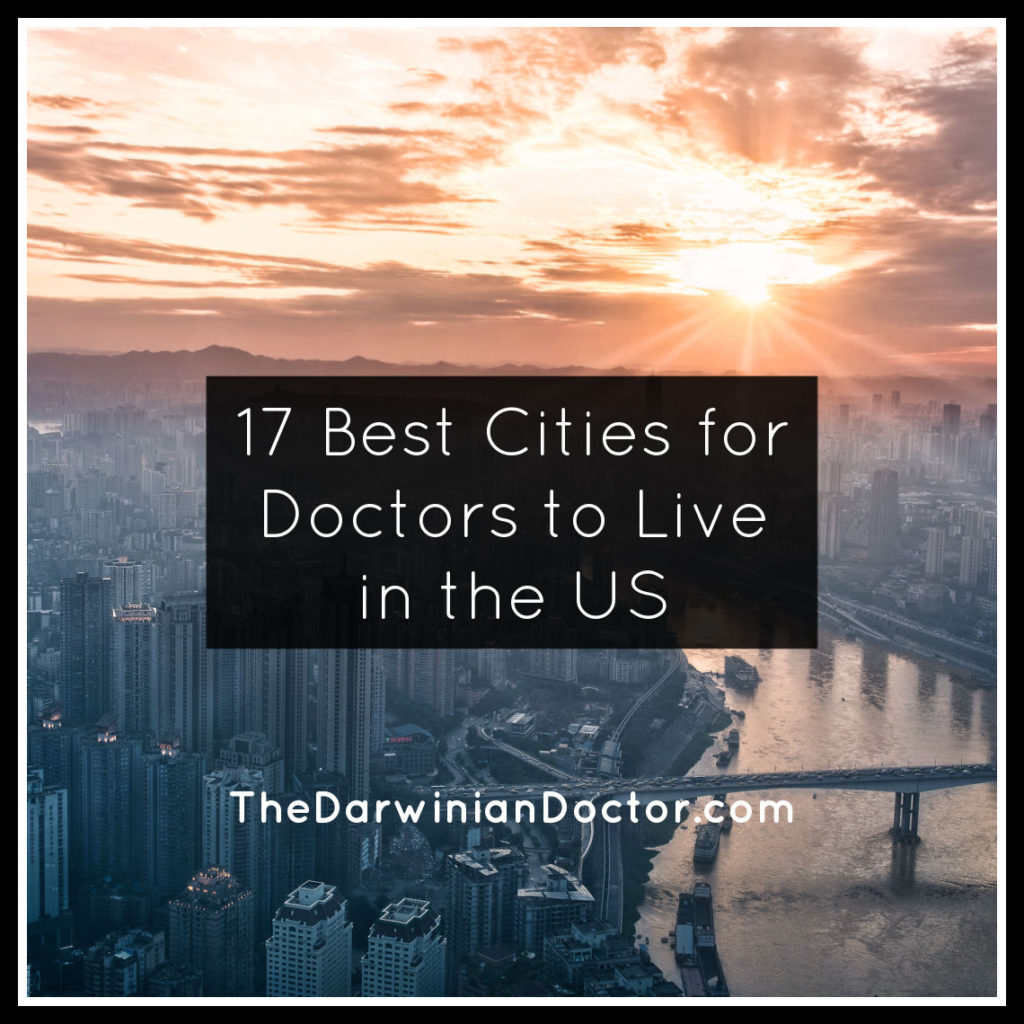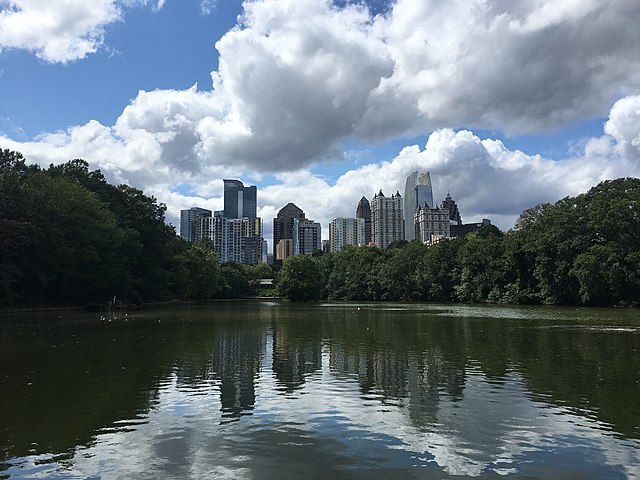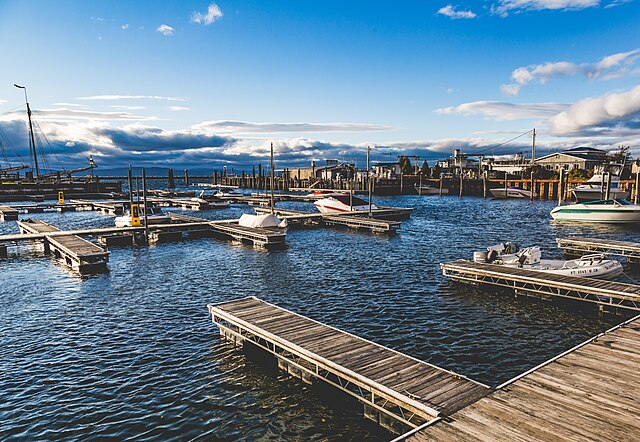Today, I share the 17 best cities for doctors to live in the US. Filtered from the collective wisdom of 4000 physicians, these suggestions are pure gold.

This post may contain affiliate links.
As my readers know, I live in Los Angeles, California. After medical school in Pennsylvania, I flew out to Los Angeles for residency training and have been here ever since. My family loves the warm climate and the beach, but LA is one of the most expensive metro areas in the US. In fact, Investopedia reports that it’s the 9th most expensive city in the country, or 73% more expensive than the rest of the nation.
We certainly spend a shocking amount of money maintaining our lifestyle in Los Angeles, though a lot of our costs are self-inflicted.
It wouldn’t be so bad if doctors could also expect a high salary here, but the average annual salary for California physicians is ranked only 26th in the United States!
It turns out that the laws of supply and demand affects physician pay, just like it affects everything else. If a lot of doctors want to live in California, employers don’t need to pay them as much.
As the White Coat Investor has said many times, California is one of the worst states for physician wealth building.
I continue to be surprised and appalled at just how difficult it is for a physician to get ahead in California.
Jim Dahle, MD (The White Coat Investor)
Should we should move away from SoCal?
When I run the numbers, it’s pretty clear that my family could achieve moFIRE much faster if we moved to a different part of the country. When I think about the specific reasons why I might uproof my family and move across the country, a lower cost of living is key.
But there’s more to this equation that cost of living. We also value things like proximity to water and good schools. With our two young boys, educational opportunities are a top consideration. And my wife and I just love being close to water. We don’t really know why we love water so much, but with the high price of waterfront real estate, I think others agree with us.
Finally, I still need to earn a living (for now), so the ability to find a good job is also an important factor.
In summary, if I’m going to make the case to move away from the natural beauty of Los Angeles, the new city will have offer a combination of four specific items:
- Lower cost of living
- Good schools (public or private)
- Proximity to water (lakes, rivers, or ocean)
- Good job opportunities for doctors
The best cities for doctors to live in the US
So what are the best states and top US cities for doctors? I surveyed a group of 4000 doctors to find out. From these physicians, I got 41 suggestions, but only some these cities had popular support and met the criteria.
There were a few notable cities that didn’t make the final list. For example, Seattle in Washington State and New York City got mentioned, but didn’t really meet the criteria in terms of better cost of living.
As a caveat, this list is taking into account the personal preferences listed above, and is certainly not from a rigorous survey. But it’s one of the only crowd-sourced lists you’re ever going to find about this topic.
If you look through these cities, you’ll find some of the best places to live and work as a doctor in this country.
Click here for an interactive Google Map of the best cities for doctors.
Click on each of the city names to jump to that section of the article, or scroll down to see the whole list.
Before we jump to the cities, make sure to sign up to our free weekly newsletter!
- Dallas, Texas
- Austin, Texas
- Indianapolis, Indiana
- Chattanooga, Tennessee
- Sugarland, Texas
- Nashville, Tennessee
- Columbia, South Carolina
- Mooresville, North Carolina
- Norfolk, Virgina
- Burlington, Vermont
- Columbus, Ohio
- Cleveland, Ohio
- Mandeville, Louisiana
- South Bend, Indiana
- Chicago, Illinois,
- Atlanta, Georgia
- Orlando, Florida
#17 – Orlando, Florida


Orlando is a city in central Florida and is home to about 280,000 people. It’s famous for theme parks like Disney World and has a humid subtropical climate. Its cost of living is 4% higher than the national average.
Doctors seemed to like this city for its proximity to three types of water: lakes, the Gulf of Mexico, and the Atlantic Ocean. It also has a strong healthcare industry with two large hospital systems.
The lack of a state income tax also was cited as a big advantage for Florida.
I was surprised that Orlando is the only Florida city on this list.
#16 – Atlanta, Georgia


Atlanta is a big city in Georgia and is home to about 500,000 people. It’s the “cultural and economic center” of the larger Atlanta metropolitan area of over six million people. It has a humid subtropical climate. It’s cost of living is 6% higher than the national average.
Doctors like Atlanta because of the booming economy and high quality of education and hospitals. For example, Emory is a world class university, and Emory Healthcare is the largest healthcare system in Georgia. A quick glance at Google Maps shows that it has a lot of natural lakes as well.
I visited Atlanta once for a wedding, but all I recall is sweltering heat and a party bus.
#15 – Chicago, Illinois
Chicago is the largest city in Illinois with over 2.7 million people. It’s the third most populous city in the nation and is located on the shores of Lake Michigan. It has a humid continental climate. Its cost of living is about 7% higher than the rest of the nation.
Doctors like this city because it’s the “best summer city” in the nation. It certainly checks off the proximity to water box, with great access to water sports year round via the Chicago river and Lake Michigan.
One strike against Illinois from a personal finance perspective is its startlingly high tax rate for your average household, at 15%.
#14 – South Bend, Indiana


South Bend is a smaller city in Indiana with a population of about 100,000 people, within a larger metropolitan area of about 300,000 people. The St. Joseph river runs right through the center of town, giving ample access to the water. It has a humid continental climate and the cost of living is 31% lower than the average US city.
It’s home to the famous University of Notre Dame and just a stone’s throw from Lake Michigan.
Doctors love South Bend because it’s a college town with “great hospital systems” with the good choice of private practice or employed jobs. Families also like the “great private and public school options.”
For water lovers, one doctor said that lake homes on Lake Michigan or other inland lakes are very common. A doctor’s salary can go a long way in a city with such a low cost of living.
#13 – Mandeville, Louisiana


Mandeville is a small town of just 13,000 people, and is just across Lake Pontchartrain from New Orleans. It has a humid subtropical climate and the cost of living is only 4% higher than the average for the US.
Doctors noted that it’s just 30 minutes north of New Orleans, but offers a small town feel. They also stated that it has multiple great medical centers and the “best schools in the state.”
As a small town, it might not appeal to those who enjoy larger cities, but it’s perhaps one way of enjoying the fun of New Orleans without being right in the midst of the Mardi Gras madness.
#12 – Cleveland, Ohio
Cleveland is the largest city on lake Erie and is home to over 380,000 people within the larger metropolitan area of over 3.5 million. It has a continental climate with all 4 seasons and an affordable cost of living that’s 27% lower than the rest of the U.S. cities.
From the physician perspective, it’s home to the famous Cleveland Clinic network of hospitals, ranked an amazing #2 in the nation by U.S. News. The cachet of the Cleveland Clinic attracts many top doctors to the city and is an overall stabilizing economic force in the region.
#11 – Columbus, Ohio


Columbus is the state capital and the largest city in Ohio, with about 900,000 people. It has a continental climate and a cost of living about 15% lower than the average US city.
It’s a big college town with the massive Ohio State University, which also has a healthcare system that employs many healthcare workers.
The Scioto river cuts right through Columbus, with nine parks along its riverbanks.
I’ve looked at Columbus a number of times as a potential real estate investment market, but found it to be a very hot market with lots of competition for good deals.
#10 – Burlington, Vermont
Burlington is the largest city in Vermont with about 43,000 people. It has a humid continental climate and its cost of living is 11.5% higher than the national average.
Keeping with the theme of college towns, Burlington is home to the University of Vermont and Champlain College.
For doctors, the UVM Medical Center provides plenty of physician jobs.
What struck me about Burlington was the truly beautiful waterfront. Check this out:

#9 – Norfolk, Virginia

Norfolk is a city in Virginia and home to about 240,000 people. It has a humid subtropical climate and the cost of living is about 8% less than the average US town.
Doctors love the low cost of living, the mild climate, and say it’s a “great place to live.”
In terms of water access, it’s right on the Atlantic Ocean where it funnels into the James River. Because of this, it has “many miles of riverfront and bayfront property, including beaches on the Chesapeake Bay.”
While I didn’t hear as much about the job opportunities, a quick search shows plenty of hospitals in the area.
#8 – Mooresville, North Carolina
Mooresville is a town of about 40,000 people located just a half hour north of Charlotte. It has a humid subtropical climate and the cost of living is about 7% higher than the rest of the nation.
Although it’s a small town, Mooresville benefits from proximity to Charlotte. It’s one of a string of towns north of Charlotte, including Huntersville, Caldwell, and Cornelius. Mooresville is particularly close to the beautiful Lake Norman.
Lake Norman is a huge man made lake and offers tons of waterfront property with year round watersports and attractions.


This next part of the list saw increasing popular support for the following cities.
#7 – Columbia, South Carolina


Columbia is the capital and second largest city in South Carolina with about 130,000 inhabitants. It has a humid subtropical climate and the cost of living is an affordable 16% lower than the rest of the US.
For water access, Columbia is located at the confluence of two rivers and therefore has tons of waterfront property.
Doctors also cited the natural resource of nearby Lake Murray, a huge 41 mile lake which offers fishing and boating. Overall, they love Columbia, calling it “beautiful and inexpensive” with “good local hospitals.”
#6 – Nashville, Tennessee


Nashville is the capital and largest city in Tennessee, with a population of almost 700,000 people. It has a humid subtropical climate and the cost of living is almost exactly at the national average.
Nashville is renowned for its music industry, and is considered by many to be the home of country music.
There are many world class institutes of higher learning, including Vanderbilt University.
For water access, the Cumberland river runs through the city, and there are many beaches along the Percy Priest Reservoir.
Doctors called it a “nice city” with lakes nearby for water lovers.
The only time I visited Tennessee was to check out real estate, and I had the worst allergy attack of my life for three days straight. If you can stand the pollen, this state has a lot going for it.
#5 – Sugar Land, Texas

Sugar Land is a large city in the Southeastern part of Texas and has a population of over 118,000 people. It has a humid subtropical climate and the cost of living is about 15% higher than the rest of the nation.
This city was mentioned several times by physicians as being very racially diverse, and the map shows that the area is dotted with many bodies of water.
One doctor stated that the fantastic schools, culture and low cost of living completely won over his “die hard east coaster” wife. If it can appeal to “die hard west coaster” wives as well, we might have a winner here.
#4 – Chattanooga, Tennessee


Chattanooga is a medium-sized city of 181,000 people along the Tennessee River. It has a humid subtropical climate and the cost of living is an affordable 16% lower than the average US city.
Doctors were very enthusiastic about Chattanooga. They called it a “great” city, and said it offers waterfront living options “on the river, or on the lake a bit further north.” They also like the warm weather and the lower cost of living. As for jobs, they cited that it has “lots of hospital options, academic included.”
One interesting fact is that a municipally owned utility company, EPB, offers 10 gigabit fiber optic internet speed. That’s 10,000 megabits per second, which basically makes Chattanooga a virtual radiologist’s dream environment.
#3 – Indianapolis, IN
Indianapolis is the capital city of Indiana, and home to about 888,000 people (or about 2.4 million in the greater metro area). It has a humid continental climate and the cost of living is 16% lower than your average US city.
Doctors gushed about Indianapolis. They said the “cost of living is amazing” with good schools. They also like the legal climate, saying that it’s “super friendly” to physicians from the legal standpoint. One physician noted that the Indiana University system pays its academic physicians surprisingly well.
For water access, the nearby Geist Reservoir offers year round water sports, boating, and fishing.


I’m partial to Indy because the majority of my real estate portfolio is in Indianapolis. The lower cost of real estate, well run city government, and booming economy are three reasons why I invest there.
#2 – Austin, Texas

Austin is the capital city of Texas and boasts almost 980,000 people. It has a humid subtropical climate and the cost of living is about 20% higher than the rest of the nation.
Doctors cited the large number of healthcare opportunities. Some complained about the rapidly rising cost of real estate, while others felt this was outweighed by the lack of a state income tax.
For water lovers, Austin offers tons of nearby lakes and rivers like Lady Bird Lake, Lake Travis, Barton Springs, and McKinney Falls. In recent years, Austin has become a technology and business hub. For example, Tesla is rapidly constructing another Gigafactory nearby.
Austin is also a cultural hub and since 1987 has hosted the annual South by Southwest film and music festival.
#1 – Dallas, Texas

Dallas is a large city in Texas with a population of over 1.3 million. It’s the center of the Dallas-Fort Worth metroplex that boasts over 7.5 million people. It has a humid subtropical climate and the cost of living is only 2% higher than your average US city.
Dallas boasts many fortune 500 companies and 41 colleges and universities in the metroplex. It was the winner in terms of physician enthusiasm.
When it comes to waterfront living, there are tons of options, many with great school districts. Some neighborhoods and areas that came up included: Westlake, Southlake, Lakewood, and the Colony.
It clearly has the water access down pat, and for employment, physicians noted UT Southwestern as a big academic employer. Dallas also benefits from the lack of state income tax that is characteristic of Texas.
One physician urged me to move there “ASAP.” He said that after 12 years in California, he’s now a Dallas convert and considering a pickup truck purchase.
Conclusion
I hope you enjoyed this list of the 17 best cities for doctors to live in the US.
The list has a mix of both metropolitan cities and small cities, but there were some common themes that emerged. Ohio and Indianapolis both had two cities on the list. Only Texas had three cities on the list.
The cost of living of these cities were both higher and lower than the national mean. The lowest cost of living city was South Bend, Indiana, and the most expensive city suggested was Austin, Texas. All of the places enjoy easy access to water and even Austin was significantly cheaper than expensive coastal cities.
Dallas was voted in as the best city for doctors based on my criteria above. No West Coast cities made the cut, and overall the top cities on this list were from the midwestern, southern, or southeastern parts of the United States.
I don’t expect I’ll be moving in the immediate future, but when I do, now I’ve got a short list of the best cities for doctors to consider for the next phase of our lives!
— TDD
What do you think of this list? Please comment below and don’t forget to subscribe to the free weekly newsletter!
Perhaps you’re more of a Facebook type?
Are you a physician, spouse, or professional and you’re interested in using Real Estate to gain financial freedom? Join us in our Facebook group and accelerate your journey!


Want to support the blog?
- Join our investor club at Cereus Real Estate
- Visit my Recommendations page
- Check out my wife’s food blog: Eat Dessert First
- Stay at our luxury short term rentals
- Check out my TikTok channel
- Follow me on Instagram
- Follow me on YouTube
- Contact me with questions




10 comments
There is definitely an opportunity for some geographic arbitrage with some of these Midwest locations. I’m in the SF Bay Area and at some point it’s hard not to take a look at the housing costs in some pretty decent cities and wonder what the hell you’re doing renting out west haha. Tough to beat the location for me though.
Well if you ever get fed up with the cost of living, here are some solid options!
I did my residency at UTSW in Dallas and my fellowship at Emory in Atlanta. Dallas is one of my favorite place I have lived. I may go back one day.
UTSW was on my rank list for residency. I could easily have ended up there. It’s funny how much the match algorithm has the power to shape the course of our lives.
This is a totally arbitrary list based on author’s opinion without much fact to support the listing. Basically your list is cheap places that have less homeless people with relatively low income tax, mostly in the south or midwest where land is cheap too.
Please do some more fact based research when presenting this kind of stuff to doctors, who based things on evidence generally. Thanks.
This list is crowd-sourced, which makes it, as you say, arbitrary. But it’s not based on my opinion. It’s based on the opinions of thousands of physicians. I’m not sure why you’re bringing up homeless people. I challenge you to find better evidence of physician preferences for living. I looked — it doesn’t exist.
Winter effects on choices 🤔
Good point — a few of these cities are really going to be tough in the winter time. Luckily there are some warm weather climates here too!
[…] 17 Best Cities for Doctors to Live in the US […]
[…] where can a doctor live to have a great life at a low cost? The Darwinian Doctor compiled a list of the best cities for physicians. I was surprised that not a single west coast town made the list. Do you think you live in a nicer […]